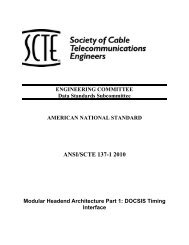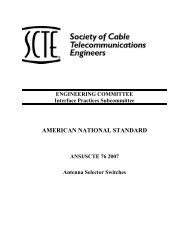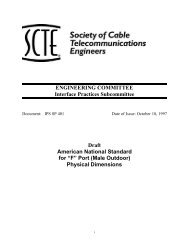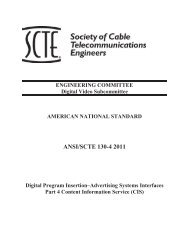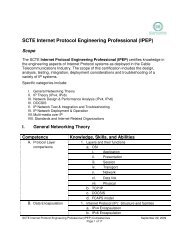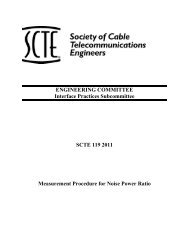SCTE IPS Template, Rev 2
SCTE IPS Template, Rev 2
SCTE IPS Template, Rev 2
- No tags were found...
You also want an ePaper? Increase the reach of your titles
YUMPU automatically turns print PDFs into web optimized ePapers that Google loves.
A typical high performance test instrument used to accomplish the above tasks is the ‘SpectrumAnalyzer’ (or, ‘SA’). Another instrument that can be used is a ‘Receiver’. Although there areReceivers classified as “general purpose” or “special purpose”, the SA can be classified as either,depending upon the specific use. However, there are usually three differences that distinguish aninstrument as either a ‘Receiver’ or as a ‘Spectrum Analyzer’. The first two differences concernhow the two instruments accomplish their frequency translation and how they display the energythey measure. The SA normally contains a “swept local oscillator” (or “swept LO”) and a widebandwidth circuit for translation of the waveform energy. This allows the instrument toefficiently display the spectral energy of a waveform over a wide frequency range. TheReceiver, however, usually contains a “discrete local oscillator” and a relatively selective circuitfor frequency translation of the waveform energy. This allows the Receiver to efficiently displaythe power of a waveform within a narrow frequency range, at any number of specific (i.e.desired) measurement frequencies (e.g. the frequency of the measurement can be abruptlychanged and the power reading taken immediately). The third difference concerns how the twoinstruments accomplish their task of demodulation. The SA normally contains only a “peaksampling detector” for demodulation and detection of the waveform’s energy. The Receiver,however, normally contains a variety of different detectors, in order to optimize the dynamicrange and accuracy of the measurement, depending upon the waveform’s characteristics.A more detailed discussion of the two instruments is covered in ANSI/<strong>SCTE</strong> 96 2007. It shouldbe noted that there are a number of subtle consequences of the AM-XMOD measurement whenone instrument is chosen over the other. Many of these involve measurement speed andrepeatability and are a matter of measurement technique. However, four issues are mostimportant to the measurement accuracy and necessitate elucidation in the present procedure.The first of these is “contribution of distortion by the measurement equipment” and must beavoided for proper dynamic range. Since a Receiver or a SA is capable of generating distortionif ‘overloaded’, proper care must be taken to ensure this is avoided. If need be, externalattenuation or pre-selection filtering must be included in the measurement setup. Commonly,rejection of energy from ‘image frequencies’ and/or ‘adjacent carriers’ is needed externally tothe SA, due to its wide bandwidth characteristics.The second issue is the “contribution of noise by the measurement equipment” and is a concernwhen the minimum levels of the distortion are obscured by the noise inherent in themeasurement system itself. A Spectrum Analyzer generally has a relatively high Noise Factor,due to the wide bandwidth nature of its internal circuits. Many times this can be overcome byincluding an external pre-amplifier in the measurement setup – however, proper selection ofamplifier’s performance is essential, to avoid contribution of distortion by the pre-amplifier(and/or the SA, from too high a signal level). Most receivers contain an internal pre-amplifierthat can be (automatically) switched into the measurement path as needed. However, dependingupon the internal pre-amplifier performance, selective filtering external to the Receiver may thenneed to be added, to limit overloading and generation of internal distortion.26



